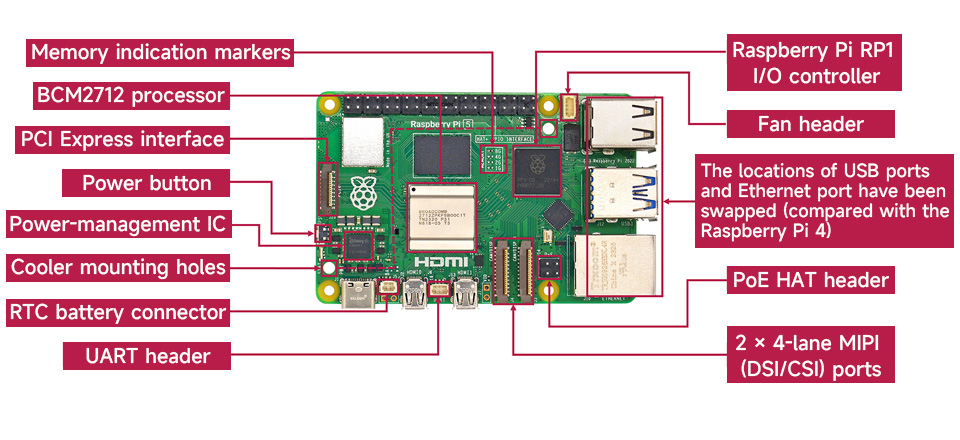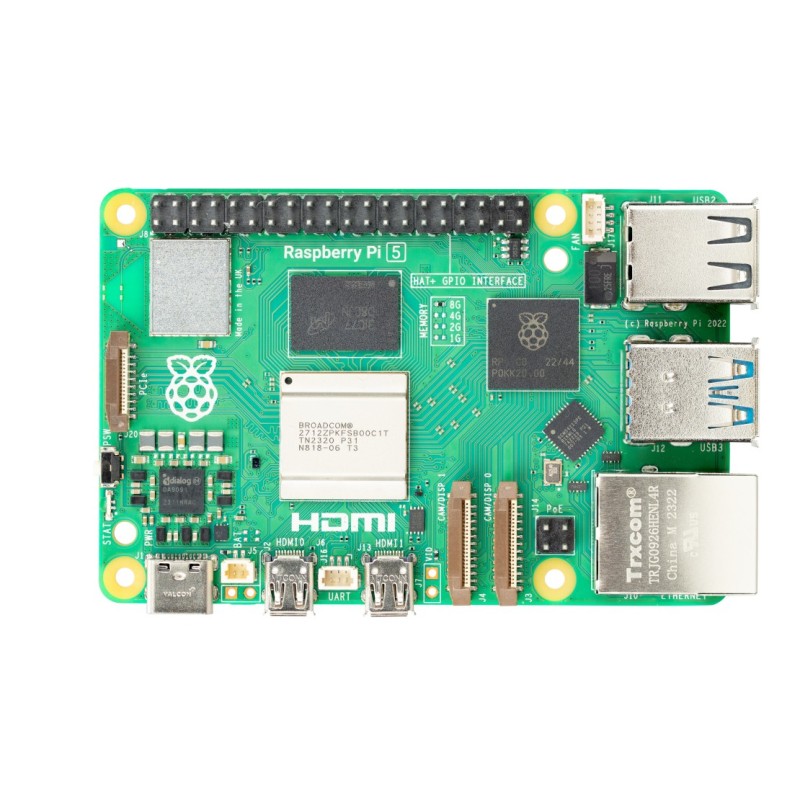Features:
- Processor: Broadcom BCM2712 (Arm Cortex A76), 64-bit 2.4GHz quad-core with 512KB L2 and 2MB shared L3 cache
- RAM: 8GB LPDDR4X
- Connectivity:
- Gigabit Ethernet
- Dual-band 802.11ac Wi-Fi (2.4GHz/5GHz)
- Bluetooth 5.0, BLE
- USB 3.0 x2 (5Gbps), USB 2.0 x2
- 2 x Micro HDMI (4Kp60 supported)
- PoE support (via HAT)
- MicroSD card slot
- 40-pin GPIO header
- 2 × 4-lane MIPI DSI/CSI interfaces
- USB Type-C (5V/5A)
- Power button
- RTC with external battery support
- PCIe 2.0 x1 interface
- UART debug header
What's On Board:

How to Use:
- Preparation: SD card, card reader
- Download the system: Click here to download
- Format the SD card: Use SDFormatter.exe
- Program the image: Use Win32DiskImager.exe
- Start RPI5: Insert SD card, connect 5V 5A Type-C adapter
- Connect peripherals: Keyboard, mouse, and display
UART Login:
The dedicated UART connector supports up to 921,600bps, providing early boot access and Linux console debugging.

RTC (Real-time Clock):
The RTC is powered using a backup battery via the J5 (BAT) connector. It continues working while the Pi is powered on.

Software Debug:
- Default device:
/dev/rtc0
- Use
date to check current system time
Hwclock Commands:
sudo hwclock -w # System clock -> RTC
sudo hwclock -s # RTC -> System clock
sudo hwclock -r # Read RTC time
sudo hwclock --set --date="9/8/2023 16:45:05"
sudo hwclock --verbose # Version info
Auto Wakeup:
sudo -E rpi-eeprom-config --edit
# Add:
POWER_OFF_ON_HALT=1
WAKE_ON_GPIO=0
# Test:
echo +600 | sudo tee /sys/class/rtc/rtc0/wakealarm
sudo halt
# Wakes up after 10 minutes
RTC Battery Charging:
sudo nano /boot/firmware/config.txt
# Add:
dtparam=rtc_bbat_vchg=3000000
3000000 means max charge voltage 3V (charging disabled at 3V, trickle below).
Dimensions:

Resources:
Features:
- Processor: Broadcom BCM2712 (Arm Cortex A76), 64-bit 2.4GHz quad-core with 512KB L2 and 2MB shared L3 cache
- RAM: 8GB LPDDR4X
- Connectivity:
- Gigabit Ethernet
- Dual-band 802.11ac Wi-Fi (2.4GHz/5GHz)
- Bluetooth 5.0, BLE
- USB 3.0 x2 (5Gbps), USB 2.0 x2
- 2 x Micro HDMI (4Kp60 supported)
- PoE support (via HAT)
- MicroSD card slot
- 40-pin GPIO header
- 2 × 4-lane MIPI DSI/CSI interfaces
- USB Type-C (5V/5A)
- Power button
- RTC with external battery support
- PCIe 2.0 x1 interface
- UART debug header
What's On Board:

How to Use:
- Preparation: SD card, card reader
- Download the system: Click here to download
- Format the SD card: Use SDFormatter.exe
- Program the image: Use Win32DiskImager.exe
- Start RPI5: Insert SD card, connect 5V 5A Type-C adapter
- Connect peripherals: Keyboard, mouse, and display
UART Login:
The dedicated UART connector supports up to 921,600bps, providing early boot access and Linux console debugging.

RTC (Real-time Clock):
The RTC is powered using a backup battery via the J5 (BAT) connector. It continues working while the Pi is powered on.

Software Debug:
- Default device:
/dev/rtc0
- Use
date to check current system time
Hwclock Commands:
sudo hwclock -w # System clock -> RTC
sudo hwclock -s # RTC -> System clock
sudo hwclock -r # Read RTC time
sudo hwclock --set --date="9/8/2023 16:45:05"
sudo hwclock --verbose # Version info
Auto Wakeup:
sudo -E rpi-eeprom-config --edit
# Add:
POWER_OFF_ON_HALT=1
WAKE_ON_GPIO=0
# Test:
echo +600 | sudo tee /sys/class/rtc/rtc0/wakealarm
sudo halt
# Wakes up after 10 minutes
RTC Battery Charging:
sudo nano /boot/firmware/config.txt
# Add:
dtparam=rtc_bbat_vchg=3000000
3000000 means max charge voltage 3V (charging disabled at 3V, trickle below).
Dimensions:

Resources:




